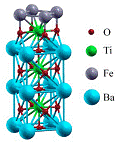Department of Physics and Astronomy: Publications and Other Research

Evgeny Tsymbal Publications
ORCID IDs
Tsymbal http://orcid.org/0000-0002-6728-5481
Paudel https://orcid.org/0000-0002-9952-9435
Document Type
Article
Date of this Version
2020
Citation
ACS Omega (2020) 5: 12,385−12,390
doi: 10.1021/acsomega.0c01139
Abstract
BaTiS3 is a semiconductor with a small bandgap of ∼0.5 eV and strong transport anisotropy caused primarily by structural anisotropy; it contains well-separated octahedral columns along the [0001] direction and low lattice thermal conductivity, appealing for thermoelectric applications. Here, we evaluate the prospect of BaTiS3 as a thermoelectric material by using the linearized electron and phonon Boltzmann transport theory based on the firstprinciples density functional band structure calculations. We find sizable values of the key thermoelectric parameters, such as the maximum power factor PF = 928 μWK−2 and the maximum figure of merit ZT = 0.48 for an electron-doped sample and PF = 74 μW K−2 and ZT = 0.17 for a hole-doped sample at room temperature, and a small doping level of ±0.25e per unit cell. The increase in temperature yields an increase in both the power factor and the figure of merit, reaching large values of PF = 3078 μWK−2 and ZT = 0.77 for the electron-doped sample and PF = 650 μW K−2 and ZT = 0.62 for the hole-doped sample at 800 K. Our results elucidate the promise of BaTiS3 as a material for the thermoelectric power generator.


Comments
Copyright 2020, the authors. Open access
License: ACS Author Choice